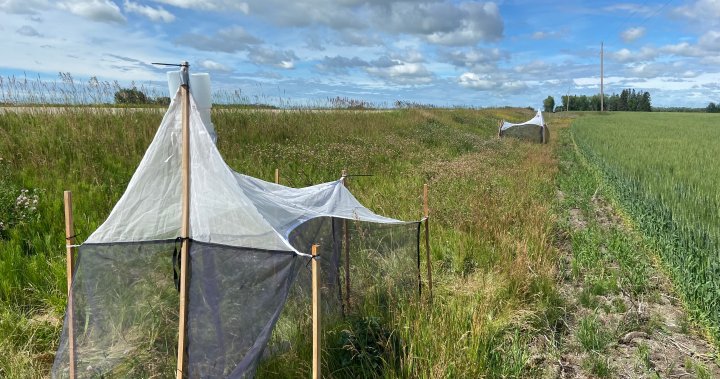The buzz of traffic isn’t the only sound you’ll hear along Alberta’s highways this summer. Among the drone of passing vehicles, researchers are tracking another vital movement – the flight paths of wild bees navigating roadside vegetation throughout the province.
On a windy Tuesday morning last week, I watched as Leithen M’Gonigle, an associate professor of biological sciences at the University of Calgary, carefully collected specimens from a series of small traps nestled among the wildflowers growing beside Highway 2 south of Calgary.
“Highways might seem like strange places to study pollinators,” M’Gonigle told me as he gently transferred a metallic green sweat bee into a collection vial. “But these linear stretches of land represent a massive, largely untapped opportunity for conservation.”
The project, launched this spring through a partnership between the University of Calgary and Alberta Transportation, aims to transform how we think about the spaces alongside our roads. The three-year study will examine how different vegetation management practices along highways affect wild bee populations.
For M’Gonigle and his team, these roadside areas represent more than just grassy buffers. They see potential sanctuaries for Alberta’s approximately 300 native bee species, many of which face mounting pressure from habitat loss, pesticide exposure, and climate change.
“We’ve lost about 97 percent of native grasslands in parts of Alberta,” explained Jessica Vickruck, a research scientist with Agriculture and Agri-Food Canada who is collaborating on the study. “When you consider that highway rights-of-way account for roughly 260,000 hectares across the province, that’s a significant amount of potential habitat that could support biodiversity.”
The study comes at a critical time. Global pollinator populations have declined dramatically in recent decades. A 2021 report from the International Union for Conservation of Nature found that more than 40 percent of insect pollinators face extinction globally. In North America, several bumble bee species have declined by up to 96 percent in recent decades.
While much attention has focused on managed honey bee colonies, wild native bees provide essential pollination services for both natural ecosystems and agriculture. Research published in Nature Communications estimates that wild pollinators contribute to the production of approximately 35 percent of global crop production.
Walking along the highway’s edge, I was surprised by the diversity of life flourishing just meters from speeding traffic. Purple coneflowers nodded in the breeze alongside goldenrod and wild bergamot, while several species of bees moved methodically between blooms.
The research team is testing different management approaches across 24 study sites spanning Alberta’s major highways. Some sections will receive diverse native wildflower seeding, others will be mowed less frequently, and control sites will maintain current management practices.
“What makes this project unique is its scale,” explained Sarah Johnson, a graduate student collecting data for the study. “We’re not just looking at isolated test plots – we’re examining how management decisions affect bee communities across different landscapes and climate zones throughout Alberta.”
Johnson showed me the collection process, which involves a combination of passive traps, visual surveys, and DNA analysis to identify species. The team’s preliminary findings already suggest that areas with more diverse native flowering plants support greater numbers and diversity of wild bees.
“It’s not just about the flowers, though,” Johnson noted. “Many of our native bees nest in the ground or in hollow plant stems. So we’re also looking at how soil disturbance, mowing frequency, and overwintering habitat affect these communities.”
Alberta Transportation’s involvement signals a shift in how infrastructure agencies approach land management. Traditionally, roadside maintenance has prioritized safety and weed control, often through frequent mowing and herbicide application.
“There’s growing recognition that these spaces can serve multiple purposes,” said Michael Edgecombe, an environmental coordinator with Alberta Transportation. “We can maintain safe roadways while also supporting biodiversity and ecosystem services.”
The ministry estimates that adjusting mowing schedules alone could save approximately $2 million annually across the province, while simultaneously reducing carbon emissions and creating more hospitable conditions for pollinators.
Similar initiatives have shown promise elsewhere. In Minnesota, the Department of Transportation’s “Roadsides for Wildlife” program has successfully integrated pollinator habitat into highway management, while the United Kingdom’s “Road Verges” initiative has helped restore native wildflower communities along transportation corridors.
What distinguishes Alberta’s approach is its emphasis on scientific monitoring to guide management decisions. The research team will track not just bee populations, but also flowering plant diversity, soil health, and maintenance costs throughout the study period.
For researchers like M’Gonigle, the project represents a shift toward what he calls “reconciliation ecology” – finding ways for human infrastructure to coexist with and support natural systems.
“We tend to think of conservation as something that happens in protected areas, far away from human activity,” he reflected as we watched a small bumble bee work its way through a patch of clover. “But the reality is that we need to find ways to share spaces, especially as development continues to fragment natural habitats.”
The study also highlights the often-overlooked importance of native bees. Unlike honey bees, which were imported from Europe and live in managed hives, Alberta’s native bees evolved alongside local plant communities over thousands of years.
“Many native plants require specific pollinators,” Vickruck explained. “Some flowers need bees that can vibrate at certain frequencies to release pollen, while others have coevolved with specialists that know exactly how to access their nectar.”
As our climate changes, these specialized relationships become even more critical. Research published in the journal Science suggests that diverse pollinator communities provide a kind of ecological insurance, with different species able to remain active under varying weather conditions.
By the end of our morning along Highway 2, M’Gonigle’s collection vials contained a surprising diversity of specimens – from tiny metallic sweat bees to robust bumble bees and several species I couldn’t identify. Each represents a piece of Alberta’s ecological heritage, and potentially, its future resilience.
For anyone driving Alberta’s highways this summer, those roadside flowers might now take on new significance. Behind their beauty lies a complex web of ecological interactions that supports our food systems, natural areas, and perhaps, with this new approach to management, a model for how human infrastructure might better coexist with the natural world.






